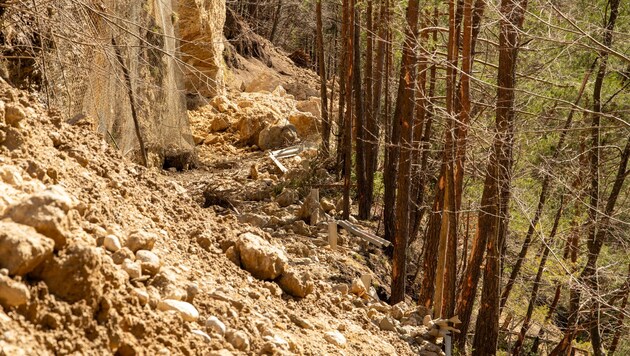Huge construction site
gun chess
A Carinthian village that can only be reached on foot or by water after a rockslide almost a year and a half ago can soon breathe a sigh of relief.
Nothing has been the same in the village of Guntschach near Maria Rain since December 15, 2022: a rockslide destroyed the road. Since then, the 70 residents have been cut off from the outside world. The volunteers of the Valentinsfähre ferry transported food, medicines, mail and people across the Drau to and from the village. An emergency road that had been built was ill-fated: In the summer of the previous year, it was destroyed by a mudslide.
Now the enormous construction site is coming to an end: Around 20,000 cubic meters of rock have been removed and the wall has been embanked to 65 degrees. "The conglomerate rock is brittle. So it had to be removed carefully, layer by layer," say Hannes Burger and Hansjörg Hufnagl from the torrent and avalanche control department.
The road should be open to traffic in mid-May. Families living in Ferlach during the construction phase will return at the end of May.
Edgar Kienleitner, Vizebürgermeister von Maria Rain
Once a section had been removed, the area was secured. Steel bolts were driven six to eight meters deep into the rock and these boreholes were filled with shotcrete. Construction site grids, some of which have coconut mats underneath to accelerate the greening, also secure the slope. Several berms, i.e. flat strips on the slope, were created. Rockfall protection nets have been installed there.
Work is still being carried out around 20 meters above the buried road; in around six weeks, the workers should have reached the road, the subsoil of which will also have to be tested. "This is all work under difficult, dangerous conditions, the geologist is there two to three times a week. Safety must come first," explains Karl Glanznig, who is the local construction supervisor.
Enormous costs
3.3 million euros are expected to be spent on the entire renovation project in Guntschach, including the emergency road. 50 percent will be covered by the federal government, 18 percent by the state and 32 percent by the municipality. "We have applied to the state for special funds and should receive another 400,000 or 500,000 euros. This money will of course affect our municipal budget for years to come," says Deputy Mayor Edgar Kienleitner.
But plans are already being made to build another danger spot just 300 meters away: the Tumplgraben. "Construction could start there in 2026," says Edgar Kienleitner, the deputy mayor of Maria Rain.
This article has been automatically translated,
read the original article here.














Kommentare
Willkommen in unserer Community! Eingehende Beiträge werden geprüft und anschließend veröffentlicht. Bitte achten Sie auf Einhaltung unserer Netiquette und AGB. Für ausführliche Diskussionen steht Ihnen ebenso das krone.at-Forum zur Verfügung. Hier können Sie das Community-Team via unserer Melde- und Abhilfestelle kontaktieren.
User-Beiträge geben nicht notwendigerweise die Meinung des Betreibers/der Redaktion bzw. von Krone Multimedia (KMM) wieder. In diesem Sinne distanziert sich die Redaktion/der Betreiber von den Inhalten in diesem Diskussionsforum. KMM behält sich insbesondere vor, gegen geltendes Recht verstoßende, den guten Sitten oder der Netiquette widersprechende bzw. dem Ansehen von KMM zuwiderlaufende Beiträge zu löschen, diesbezüglichen Schadenersatz gegenüber dem betreffenden User geltend zu machen, die Nutzer-Daten zu Zwecken der Rechtsverfolgung zu verwenden und strafrechtlich relevante Beiträge zur Anzeige zu bringen (siehe auch AGB). Hier können Sie das Community-Team via unserer Melde- und Abhilfestelle kontaktieren.